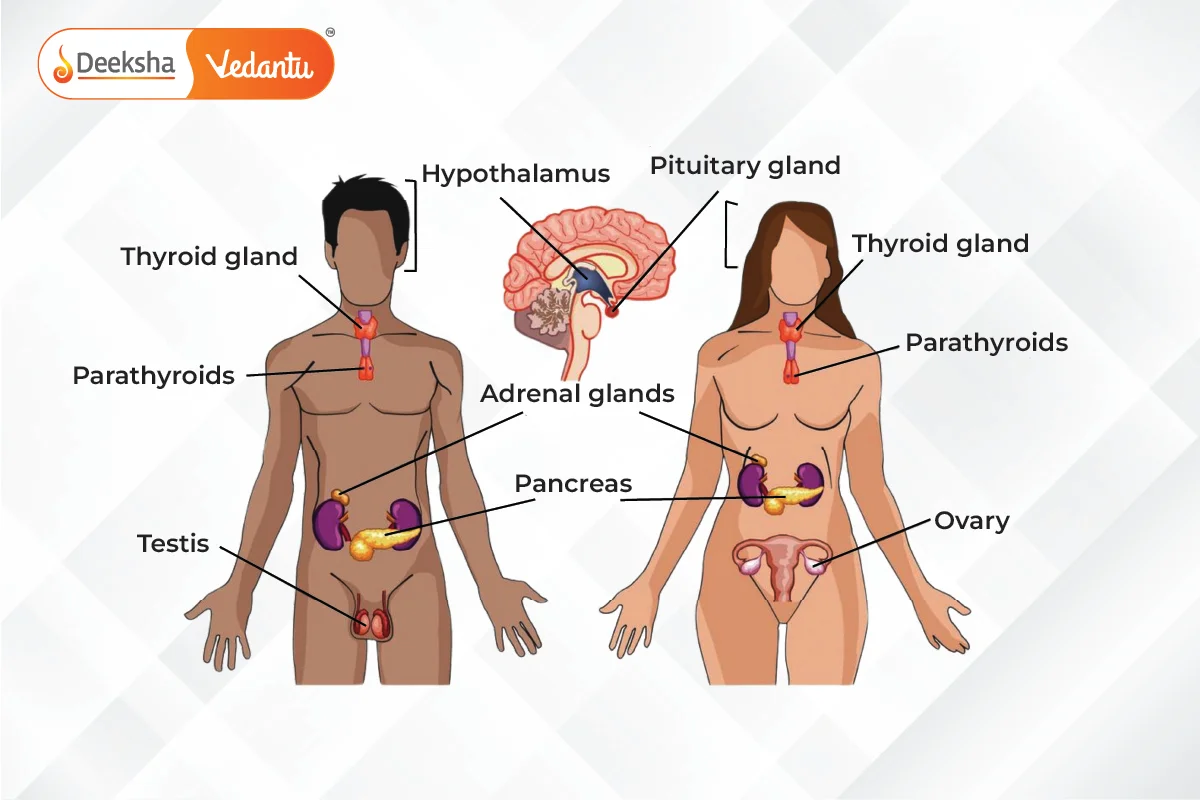Introduction
Hormones are critical chemical messengers in animals, responsible for regulating various physiological processes, including growth, metabolism, reproduction, and responses to environmental stimuli. These hormones are secreted by endocrine glands, which release them directly into the bloodstream. Hormones travel throughout the body but only affect specific target cells that have the appropriate receptors for those hormones. The endocrine system, in contrast to the nervous system, usually triggers slower but longer-lasting responses in the body.
The Endocrine System in Animals
The endocrine system consists of a network of glands that secrete hormones to regulate bodily functions. Unlike the nervous system, which transmits signals quickly through electrical impulses, the endocrine system communicates through chemicals (hormones) that travel through the blood to reach target cells. The effects of hormones may take minutes, hours, or even days to manifest, but their impact is long-lasting.
Key Endocrine Glands in Animals

- Pituitary Gland:
- Also called the “master gland” because it controls the activity of other endocrine glands.
- Located at the base of the brain, it produces hormones that regulate growth, metabolism, and reproduction.
- Major hormones include:
- Growth Hormone (GH): Stimulates body growth, especially during childhood and adolescence.
- Thyroid-Stimulating Hormone (TSH): Stimulates the thyroid gland to produce thyroxine.
- Adrenocorticotropic Hormone (ACTH): Stimulates the adrenal glands to produce cortisol.
- Thyroid Gland:
- Located in the neck, it produces hormones that regulate metabolism, growth, and development.
- Thyroxine (T4) and Triiodothyronine (T3) are essential for regulating metabolic rate, heart function, and digestive health.
- Adrenal Glands:
- Located on top of each kidney, these glands produce hormones like adrenaline (epinephrine) and cortisol.
- Adrenaline plays a vital role in the body’s “fight-or-flight” response to stress, increasing heart rate, breathing rate, and blood sugar levels.
- Cortisol helps regulate metabolism, reduces inflammation, and controls the body’s use of carbohydrates, fats, and proteins.
- Pancreas:
- The pancreas is both an endocrine and exocrine gland. Its endocrine function involves producing hormones that regulate blood sugar levels.
- Insulin lowers blood glucose levels by promoting glucose uptake in cells.
- Glucagon raises blood glucose levels by promoting the release of glucose from the liver.
- Ovaries (in females):
- The ovaries produce estrogen and progesterone, which regulate the menstrual cycle, pregnancy, and the development of secondary sexual characteristics such as breast development.
- Testes (in males):
- The testes produce testosterone, which is essential for sperm production and the development of secondary sexual characteristics like facial hair and a deep voice.
Mechanism of Hormonal Action
Hormones operate by binding to specific receptors located on or inside the target cells. The mechanism by which hormones exert their effects varies depending on the type of hormone and the location of the receptor.
- Hormones Binding to Cell Surface Receptors:
- Water-soluble hormones, like insulin and adrenaline, cannot pass through the cell membrane. Instead, they bind to receptors on the surface of the target cells.
- This triggers a cascade of reactions inside the cell (known as a signal transduction pathway) that leads to the desired effect, such as the conversion of glucose into glycogen or the release of glucose into the bloodstream.
- Hormones Binding to Intracellular Receptors:
- Lipid-soluble hormones, such as steroid hormones (e.g., estrogen, testosterone), can easily pass through the cell membrane. They bind to receptors inside the cell, usually in the cytoplasm or nucleus.
- Once inside the nucleus, the hormone-receptor complex directly influences gene expression, leading to the synthesis of new proteins that alter the cell’s function.
Example: Insulin binds to receptors on the surface of muscle and liver cells, which activates a signaling pathway that results in the uptake of glucose from the blood and its storage as glycogen.
Important Hormones in Animals and Their Functions
Growth Hormone (GH) – Pituitary Gland
- Function: Stimulates growth of bones and muscles, especially during childhood and adolescence. It also regulates body composition, muscle mass, and bone density.
- Imbalance: Excess GH during childhood leads to gigantism, while a deficiency causes dwarfism.
Thyroxine (T4) and Triiodothyronine (T3) – Thyroid Gland
- Function: Regulate metabolism, heart rate, and digestive functions. These hormones control how the body uses energy and are essential for normal growth and development.
- Imbalance: An underactive thyroid (hypothyroidism) can lead to fatigue, weight gain, and slowed metabolism. An overactive thyroid (hyperthyroidism) can cause weight loss, rapid heartbeat, and irritability.
Adrenaline (Epinephrine) – Adrenal Glands
- Function: Prepares the body for fight-or-flight responses during stressful situations. It increases heart rate, blood pressure, and blood sugar levels, allowing the body to respond to immediate threats.
- Imbalance: Overproduction can cause hyperactivity, anxiety, and high blood pressure, while underproduction may impair the body’s ability to handle stress.
Cortisol – Adrenal Glands
- Function: Regulates metabolism, reduces inflammation, and helps the body cope with stress by mobilizing energy stores.
- Imbalance: Chronic overproduction of cortisol (due to long-term stress) can lead to conditions like Cushing’s syndrome, characterized by weight gain, high blood pressure, and muscle weakness.
Insulin – Pancreas
- Function: Helps lower blood glucose levels by promoting the uptake of glucose into cells, where it is used for energy or stored as glycogen in the liver and muscles.
- Imbalance: Insufficient insulin production leads to diabetes mellitus, where blood glucose levels remain elevated, causing complications like nerve damage, kidney disease, and cardiovascular problems.
Glucagon – Pancreas
- Function: Raises blood glucose levels by promoting the breakdown of glycogen into glucose in the liver.
- Imbalance: Excessive glucagon can contribute to hyperglycemia (high blood sugar levels).
Estrogen – Ovaries
- Function: Regulates the menstrual cycle, promotes the development of female secondary sexual characteristics, and maintains the health of reproductive organs.
- Imbalance: Estrogen deficiency can lead to osteoporosis (bone thinning), irregular menstrual cycles, and infertility.
Testosterone – Testes
- Function: Regulates sperm production and the development of male secondary sexual characteristics, such as facial hair, deep voice, and muscle mass.
- Imbalance: Low testosterone levels can result in infertility, reduced muscle mass, and fatigue.
The below provided table should help you remember and review the key information about the hormones, their functions, and the consequences of their imbalances.
| Hormone | Source Gland | Function | Imbalance |
| Growth Hormone (GH) | Pituitary Gland | Stimulates growth of bones and muscles, regulates body composition, muscle mass, and bone density. | Excess leads to gigantism, deficiency causes dwarfism. |
| Thyroxine (T4) & Triiodothyronine (T3) | Thyroid Gland | Regulates metabolism, heart rate, and digestive functions, essential for growth and development. | Hypothyroidism: fatigue, weight gain; Hyperthyroidism: weight loss, rapid heartbeat. |
| Adrenaline (Epinephrine) | Adrenal Glands | Prepares the body for fight-or-flight, increases heart rate, blood pressure, and blood sugar levels. | Overproduction: hyperactivity, anxiety; Underproduction: impaired stress response. |
| Cortisol | Adrenal Glands | Regulates metabolism, reduces inflammation, helps cope with stress by mobilizing energy stores. | Overproduction causes Cushing’s syndrome: weight gain, high blood pressure. |
| Insulin | Pancreas | Lowers blood glucose levels by promoting glucose uptake into cells, stored as glycogen. | Insufficient production causes diabetes mellitus: elevated blood glucose levels, complications. |
| Glucagon | Pancreas | Raises blood glucose levels by promoting the breakdown of glycogen into glucose. | Excess glucagon can lead to hyperglycemia. |
| Estrogen | Ovaries | Regulates the menstrual cycle, promotes female secondary sexual characteristics, maintains reproductive health. | Deficiency leads to osteoporosis, irregular menstrual cycles, infertility. |
| Testosterone | Testes | Regulates sperm production and male secondary sexual characteristics such as facial hair and muscle mass. | Low levels result in infertility, reduced muscle mass, and fatigue. |
Feedback Mechanism in Hormonal Control
Hormonal control in animals often works through a feedback mechanism, primarily negative feedback loops. In a negative feedback loop, the secretion of a hormone is regulated by the concentration of its product or the condition it controls. If the hormone’s effect reaches a certain threshold, the gland reduces the hormone’s production.
Example of Negative Feedback: Regulation of Blood Sugar
- After eating a meal, blood glucose levels rise. In response, the pancreas secretes insulin, which helps cells absorb glucose, lowering blood glucose levels. Once blood glucose levels return to normal, insulin secretion decreases.
- Similarly, when blood sugar levels drop, the pancreas secretes glucagon, which triggers the liver to release glucose into the blood. Once blood glucose returns to normal, glucagon secretion decreases.
Example of Positive Feedback:
- During childbirth, the hormone oxytocin is released to stimulate uterine contractions. As contractions intensify, more oxytocin is released, further strengthening the contractions. This positive feedback continues until the baby is born.
Hormonal Imbalances and Their Effects
Hormonal imbalances can lead to a variety of health issues, as hormones regulate critical bodily functions. When hormones are either overproduced or underproduced, the body’s normal functions can be disrupted.
Common Disorders Related to Hormonal Imbalance:
- Hypothyroidism:
- Caused by low levels of thyroid hormones (T3 and T4). Symptoms include fatigue, weight gain, cold intolerance, and slowed heart rate.
- Treatment: Thyroid hormone replacement therapy.
- Hyperthyroidism:
- Results from the overproduction of thyroid hormones. Symptoms include weight loss, increased heart rate, irritability, and sweating.
- Treatment: Medications, radioactive iodine therapy, or surgery to remove part of the thyroid gland.
- Diabetes Mellitus:
- Occurs when the pancreas produces insufficient insulin (Type 1 diabetes) or the body cannot effectively use the insulin it produces (Type 2 diabetes). Symptoms include frequent urination, excessive thirst, and high blood glucose levels.
- Treatment: Insulin injections (for Type 1) and medications to increase insulin sensitivity (for Type 2).
- Cushing’s Syndrome:
- Caused by prolonged exposure to high levels of cortisol. Symptoms include weight gain, high blood pressure, and muscle weakness.
- Treatment: Medications to reduce cortisol production or surgery to remove the adrenal gland.
Real-Life Application: Hormone Therapy
Hormone therapy is widely used in medicine to treat hormonal imbalances or deficiencies. For example:
- Insulin therapy is essential for individuals with diabetes who cannot produce sufficient insulin on their own.
- Hormone replacement therapy (HRT) is often used to treat menopause symptoms in women by providing estrogen and progesterone.
- Thyroid hormone replacement therapy helps individuals with hypothyroidism manage their metabolic functions.
Practice Questions
Q1: Describe the function of adrenaline in the body.
- Answer: Adrenaline, secreted by the adrenal glands during stressful situations, increases heart rate, breathing rate, and glucose availability, preparing the body for “fight-or-flight” responses.
Q2: How does insulin regulate blood glucose levels?
- Answer: Insulin promotes the uptake of glucose into cells from the bloodstream, lowering blood sugar levels and facilitating its use for energy or storage as glycogen.
Q3: Explain how the negative feedback mechanism controls thyroid hormone levels.
Answer: When thyroid hormone levels are low, the pituitary gland releases TSH, which stimulates the thyroid to produce more thyroxine. As thyroxine levels rise, TSH secretion decreases, regulating the hormone’s levels.
FAQs
Thyroxine regulates metabolism, ensuring that the body’s cells receive enough energy for normal functioning.
Estrogen (in females) and testosterone (in males) regulate the development of secondary sexual characteristics, such as breast development in girls and facial hair in boys, during puberty.
Adrenaline increases heart rate, breathing rate, and blood glucose levels to prepare the body for the “fight-or-flight” response in stressful situations.
Insulin helps lower blood glucose levels by promoting the uptake of glucose into cells, where it can be used for energy or stored as glycogen.







Get Social